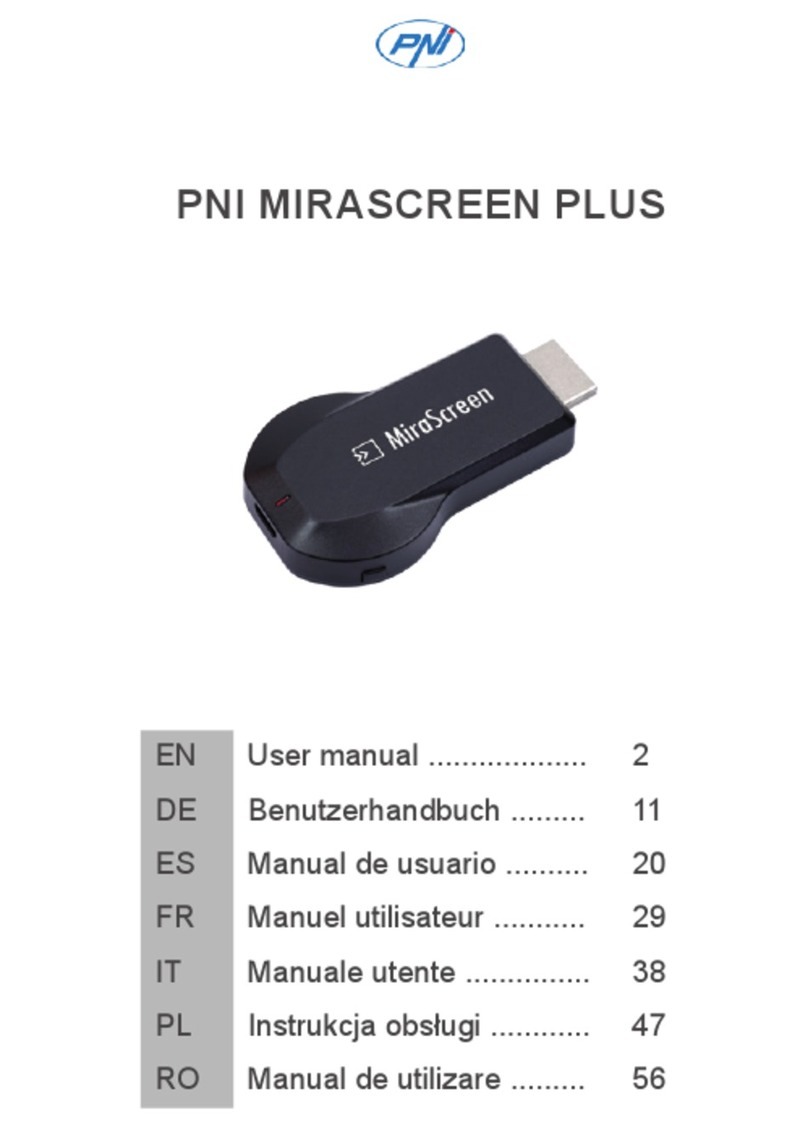
Page 2 of 48
© Copyright
PNI Corporation 2005
All Rights Reserved. Reproduction, adaptation, or
translation without prior written permission is prohibited,
except as allowed under copyright laws.
Part No. 12413
Document No. 1007535
Revision 5
April 2006
Printed in USA
PNI Corporation
133 Aviation Blvd, Suite 101
Santa Rosa, CA 95403, USA
Tel: (707) 566-2260
Fax: (707) 566-2261
Conventions Used in this Manual.
Any data that is sent to or received from the
TCM2.5/2.6 is presented in monospace font, for
example: $C326.3*checksum<cr><lf>. Place
markers for ASCII characters are indicated by the
character “n.” Any monospace characters in straight
brackets denote transmitted data that may or may not
be in the character string, depending on the
circumstances. For instance [Ennn] is the error code
string that is output by the TCM2.6 only when an error
condition exists. Also,(-) denotes the presence of a
negative sign in a character string when the
corresponding value is negative. The parentheses are
not included in the output string, and only serve to
demark the hyphen.
TCM2.6 commands can be identified either by their
mnemonic, for example, h, or by their full name, for
example, Halt continuous sampling.
Items in angle brackets either denote special characters
or summary data, for example, <cr> denotes the
carriage return character, <lf> denotes a line feed, and
<error code> denotes all the characters for an error
code string.
Warranty and Limitation of Liability. PNI Corporation
("PNI") manufactures its TCM products (“Products”)
from parts and components that are new or equivalent
to new in performance. PNI warrants that each Product
to be delivered hereunder, if properly used, will, for one
year following the date of shipment unless a different
warranty time period for such Product is specified: (i) in
PNI’s Price List in effect at time of order acceptance; or
(ii) on PNI’s web site (www.pnicorp.com) at time of
order acceptance, be free from defects in material and
workmanship and will operate in accordance with PNI’s
published specifications and documentation for the
Product in effect at time of order. PNI will make no
changes to the specifications or manufacturing
processes that affect form, fit, or function of the Product
without written notice to the OEM, however, PNI may at
any time, without such notice, make minor changes to
specifications or manufacturing processes that do not
affect the form, fit, or function of the Product. This
warranty will be void if the Products’ serial number, or
other identification marks have been defaced, damaged,
or removed. This warranty does not cover wear and
tear due to normal use, or damage to the Product as
the result of improper usage, neglect of care, alteration,
accident, or unauthorized repair.
THE ABOVE WARRANTY IS IN LIEU OF ANY OTHER
WARRANTY, WHETHER EXPRESS, IMPLIED, OR
STATUTORY, INCLUDING, BUT NOT LIMITED TO,
ANY WARRANTY OF MERCHANTABILITY, FITNESS
FOR ANY PARTICULAR PURPOSE, OR ANY
WARRANTY OTHERWISE ARISING OUT OF ANY
PROPOSAL, SPECIFICATION, OR SAMPLE. PNI
NEITHER ASSUMES NOR AUTHORIZES ANY
PERSON TO ASSUME FOR IT ANY OTHER
LIABILITY.
If any Product furnished hereunder fails to conform to
the above warranty, OEM’s sole and exclusive remedy
and PNI’s sole and exclusive liability will be, at PNI’s
option, to repair, replace, or credit OEM’s account with
an amount equal to the price paid for any such Product
which fails during the applicable warranty period
provided that (i) OEM promptly notifies PNI in writing
that such Product is defective and furnishes an
explanation of the deficiency; (ii) such Product is
returned to PNI’s service facility at OEM’s risk and
expense; and (iii) PNI is satisfied that claimed
deficiencies exist and were not caused by accident,
misuse, neglect, alteration, repair, improper installation,
or improper testing. If a Product is defective,
transportation charges for the return of the Product to
OEM within the United States and Canada will be paid
by PNI. For all other locations, the warranty excludes all
costs of shipping, customs clearance, and other related
charges. PNI will have a reasonable time to make
repairs or to replace the Product or to credit OEM’s
account. PNI warrants any such repaired or
replacement Product to be free from defects in material
and workmanship on the same terms as the Product
originally purchased.
Except for the breach of warranty remedies set forth
herein, or for personal injury, PNI shall have no liability
for any indirect or speculative damages (including, but
not limited to, consequential, incidental, punitive and
special damages) relating to the use of or inability to
use this Product, whether arising out of contract,
negligence, tort, or under any warranty theory, or for
infringement of any other party’s intellectual property
rights, irrespective of whether PNI had advance notice
of the possibility of any such damages, including, but
not limited to, loss of use, revenue or profit. In no event
shall PNI’s total liability for all claims regarding a
Product exceed the price paid for the Product. PNI
neither assumes nor authorizes any person to assume
for it any other liabilities.
Some states and provinces do not allow limitations on
how long an implied warranty lasts or the exclusion or
limitation of incidental or consequential damages, so
the above limitations or exclusions may not apply to you.
This warranty gives you specific legal rights and you
may have other rights that vary by state or province.






























